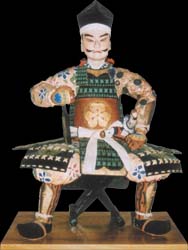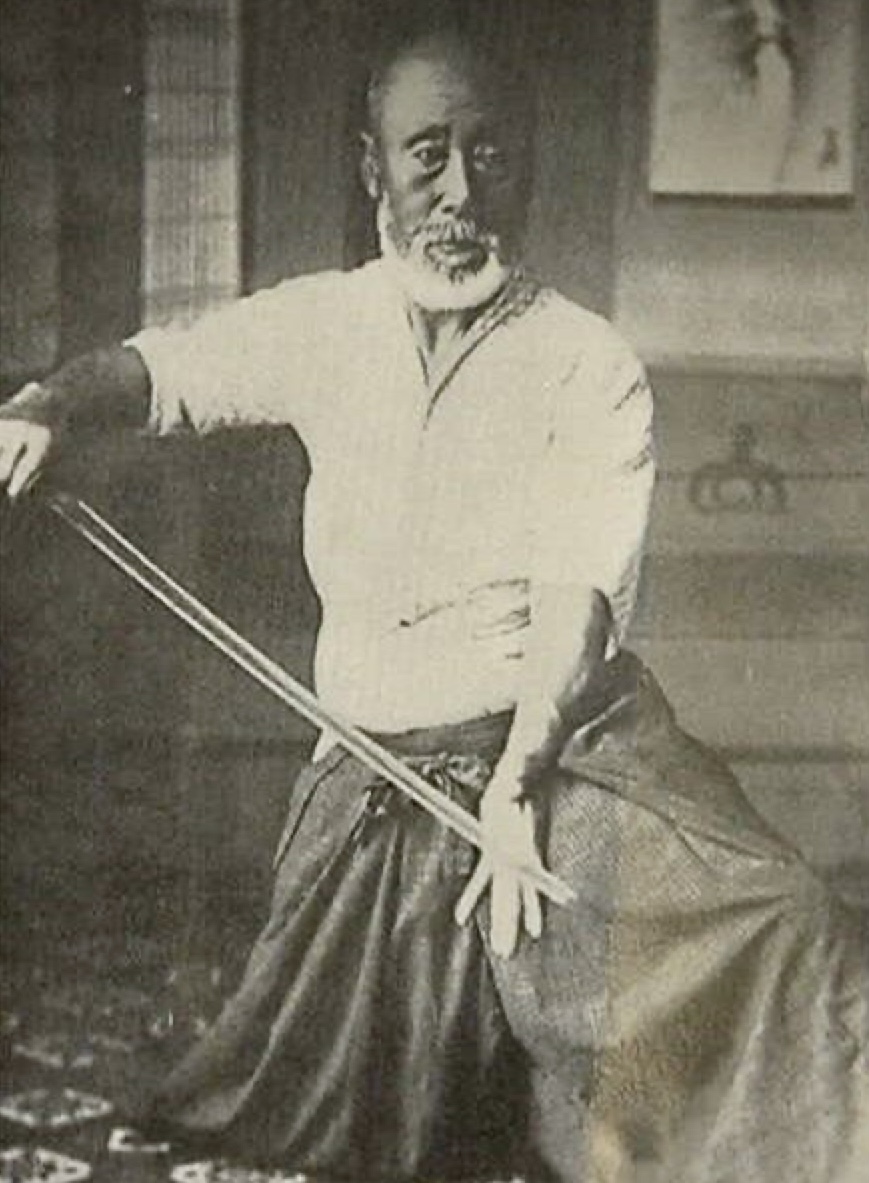
Muso Jikiden Eishin Ryu (peerless, directly transmitted school of Eishin), to give the full title of the martial art of Iaido, is well known in the central regions of Japan. The history of Eishin-ryu goes back more than 450 years, when its foundations were laid by Hayashizaki Jinsuke Minamoto no Shigenobu (1546 - 1621). He was born in the province of Dewa no kuni or Oshu (present day Yamagata prefecture) during the Ashikaga Period and was a retainer of the Mogami clan.
Hayashizaki grew up in condition of constant domestic warfare, and got to know several styles of sword-fighting at an early age. Seeking revenge for the killing of his father the 14-year-old Hayashizaki Jinsuke made a pilgrimage to the Hayashizaki Myōjin shrine, where he spent one hundred days of prayers and training.
According to legend, it was during this time that he received divine inspiration for a new way of unsheathing the sword and created Batto jutsu, giving it the name of Hayashizaki Shin Muso Ryu. His school was based on techniques for quickly drawing the sword, defence and counter-attacks. At the same time, this system started to treat weapons as means of knowledge and improvement.
Hayashizaki Jinsuke attracted most of his followers during his travels throughout Japan. As a result of his influence more than 200 schools started to develop in places he had visited on his trips.
He can rightly be seen as the most prominent actor during the old period in the history of Iai — he was a teacher and a source of inspiration for many later masters of this art.
The system created by Hayashizaki Jinsuke Shigenobu was continued by the second master - Tamiya Heibei Shigemasa, the founder of the Tamiya Ryu school. Tamiya Heibei Shigemasa is also known as a military advisor to the first three Tokugawa shoguns.
A more detailed organisation of this style was carried out under the direct influence of the 7th master — Hasegawa Chikaranosuke Eishin. He studied Iaijutsu under Banno Nobusado, using the methods of Rinzaki Ryu, in Edo during the Kyoho Period (1716-1735) and earned a reputation as an exceptionally masterful swordsman. It has been claimed that he changed many techniques, and that he was the one who came up with the approach of performing techniques with a sword that was put behind the belt with the cutting edge facing up. Some also credit Hasegawa Eishin for introducing the name “Muso Jikiden” — peerless, directly transmitted (from teacher to student) style.
At the same time, he used the name of an older school of complex art of war — Muso Jikiden Ryu Hei jutsu that he headed as its 19th master.
He brought his style from Edo to the Tosa clan on the island of Shikoku where it has been maintained all the way to modern time. In this branch of Iai techniques are performed from the position of “tate hiza” (where the swordsman sits with the right knee raised above ground and the left foot tucked under the backside). Most Iaido researchers assume that Hasegawa Eishin also had a role to play in the creation of the name Eishin-ryu, as both names are constructed using the same Japanese characters.
Further changes and improvements were made by the 9th master Hayashi Rokudayu Morimasa, who was a vassal of Yamanouchi Toyamasa, the 4th head of the province, and studied Shinmei Muso Ryu under the master Arai Seitetsu Kiyonobu in Edo. He also studied techniques of Saya no Uchi Batto Gohan Shinkage Ryu ken-jutsu under Omori Rokurozaemon Masamitsu, who went on to create his own sytle of Iai “Omori Ryu” that was practised from the position of seiza, zashiki and also taught it to Hayashi Morimasa. It is unclear whether the following changes were introduced by Hayashi (Omori) Rokudayu Morimasa or Omori Rokurozaemon Masamitsu, who was also teaching in the school, but the system received a greeting ceremony (Reishiki) that was borrowed from Ogasawara Ryu — seiza (kneeling position) and sword-fighting techniques performed from this position.
After the passing of Oguro Motoemon Kiyokatsu, the 11th head of school in the Ryu generation, the school split into two branches or Ha, named after two most accomplished students who established their distinct styles: Tanimura Ha and Shimomura Ha.

The first student was known as Tanimura Kameno Jo Yorikatsu, and his style had a more direct connection with Tosa Iai and later transformed into Muso Jikiden Eishin Ryu. The other student was known as Shimomura Moichi Sadamasa, and he introduced significant changes. In the 20th century the Shimomura Ha was renamed as Muso Shinden Ryu.
The Tanimura Ha branch of the style can be tracked back to the 17th patriarch of the style, Oe Masamichi, who was the soke (head of school) in the 15th generation of the Shinomura Ha branch, but later joined the Tanimura Ha and became the 17th head of school. Oe Masamichi had the greatest influence on modern Muso Jikiden Eishin ryu.
It was during his time that the school acquired its formal name “Muso Jikiden Eishin Ryu”, he changed the “closed door” policy, reviewed and standardised many existing methods that he saw as overly complicated, introduced a streamlined terminology and the training programme was fully formed, including such techniques as Omori Ryu, Hasegawa Eishin Ryu, Eishin ryu Oku iai Iwaza no bu, Eishin Ryu Oku iai Tachi waza no bu, Koden Eishin Ryu kata Tachi uchi no Kurai, Eishin Ryu kata Tsume Ai no kurai, and the existing list of techniques received new difficult training methods of Hayanuki no bu, Bangai no bu, as well as other methods of Kae waza and Henka Waza.
On top of that he trained many outstanding masters of the sword, many of whom had their own ideas about the further development of the school.
Muso Jikiden Eishin Ryu (Seito line)
1. Hayashizaki Jinsuke Minomoto no Shigenobu, founder of ‘’Hayashizaki Shin Muso Ryu’’
2. Tamiya Heibei Shigemasa
3. Nagano Muraku Nyūdō Kinrosai
4. Todo Gunbei Mitsushige
5. Arikawa Seizaemon Munetsugu
6. Banno Danemonno-Jō Nobusada
7. Hasegawa Chikaranosuke Eishin (Hidenobu), founder of ‘’Hasegawa Eishin Ryu’’
8. Arai Seitetsu Kiyonobu
9. Hayashi Rokudayū Morimasa
10. Hayashi Yasudayū Masutomo (Seisho)
11. Ōguro Motoemon Kiyokatsu
12. Hayashi Masuno-Jō Masanori
13. Yoda Manzō Toshikatsu
14. Hayashi Yadayū Masatoshi
15. Tanimura Kameno-Jō Yorikatsu
16. Gotō Magobei Masasuke
17. Ōe Masamichi (Masaji) Shikei (1852–1927), founder of ‘’Muso Jikiden Eishin Ryu’’
18. Hokiyama Namio (1891-1935)
19. Fukui Harumasa (1884-1971)
20. Kōno Hyakuren (Minoru) (1899-1974)
21. Fukui Torao (1915-2000)
22. Ikeda Takashi (Seigo) (1932-2019)
23. Fukui Masato
